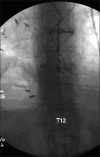Spinal cord stimulation: Current applications for treatment of chronic pain
- PMID: 25885295
- PMCID: PMC4173369
- DOI: 10.4103/0259-1162.84174
Spinal cord stimulation: Current applications for treatment of chronic pain
Abstract
Spinal cord stimulation (SCS) is thought to relieve chronic intractable pain by stimulating nerve fibers in the spinal cord. The resulting impulses in the fibers may inhibit the conduction of pain signals to the brain, according to the pain gate theory proposed by Melzack and Wall in 1965 and the sensation of pain is thus blocked. Although SCS may reduce pain, it will not eliminate it. After a period of concern about safety and efficacy, SCS is now regaining popularity among pain specialists for the treatment of chronic pain. The sympatholytic effect of SCS is one of its most interesting therapeutic properties. This effect is considered responsible for the effectiveness of SCS in peripheral ischemia, and at least some cases of complex regional pain syndrome. The sympatholytic effect has also been considered part of the management of other chronic pain states such as failed back surgery syndrome, phantom pain, diabetic neuropathy, and postherpetic neuralgia. In general, SCS is part of an overall treatment strategy and is used only after the more conservative treatments have failed. The concept of SCS has evolved rapidly following the technological advances that have produced leads with multiple contact electrodes and battery systems. The current prevalence of patients with chronic pain requiring treatment other than conventional medical management has significantly increased and so has been the need for SCS. With the cost benefit analysis showing significant support for SCS, it may be appropriate to offer this as an effective alternative treatment for these patients.
Keywords: Back pain; chronic pain; failed back surgery; spinal cord injury; spinal cord stimulator.
Conflict of interest statement
Figures



References
-
- Shealy CN, Mortimer JT, Reswick JB. Electrical inhibition of pain by stimulation of the dorsal columns: Preliminary clinical report. Anesth Analg. 1967;46:489–91. - PubMed
-
- Shealy CN, Mortimer JT, Hagfors NR. Dorsal column electroanalgesia. J Neurosurg. 1970;32:560–4. - PubMed
-
- Melzack R, Wall PD. Pain mechanisms: A new theory. Science. 1965;150:971–9. - PubMed
-
- Alfano S, Darwin J, Picullel B. Spinal cord stimulation: Patient management guidelines for clinicians. Medtronic, undated. [Last accessed on 2011 March 18]. Available from: http://www.medtronic.com/neuro/paintherapies/pain_treatment_ladder/pdf/1... .
-
- Segal R, Ott M, Levy E, Richard R. Prospective study of long-term results of totally implantable spinal cord stimulation (SCS) in a cohort of 78 patients. Neurosurgery. 1999;45:696.
Publication types
LinkOut - more resources
Full Text Sources
